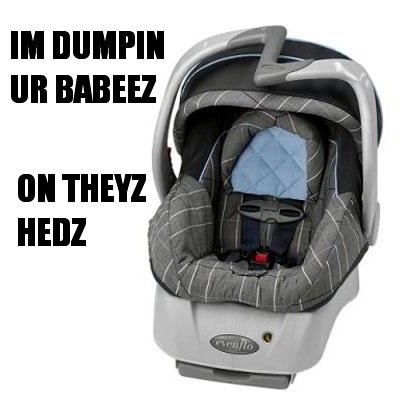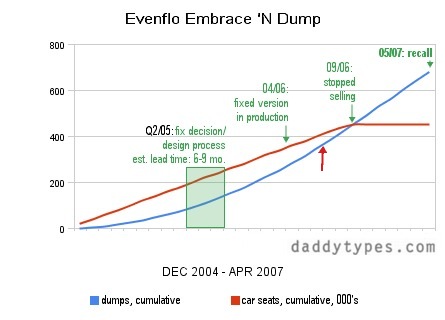
So yeah, all that stuff about how the Evenflo Embrace-n-Dump car seat recall was only the latest in a 10-year string of recalls for the exact same problem, and no one's really noticed or done anything about it, and the CPSC has been really kind of slow to pick up on it, and the fact people think a car seat is totally safe because it's been tested, right? even though no one really does meaningful tests about using it as a carrier outside of a car, and how the fact that two government agencies sharing jurisdiction over this single category of product totally hinders product recalls but also presents a near-insurmountable obstacle to crafting a meaningful solution? I totally called that.
This afternoon, I spoke with Don Mays, who is Senior Director of Product Safety and Consumer Sciences at Consumers Union, the publisher of Consumer Reports. As it turns out, Mr. Mays was just preparing to publish some followup on CR's Safety Blog about CU's behind-the-scenes work on the Evenflo Embrace recall in particular, but also on the larger issue of safety when car seats are used as infant carriers.
That post is up now, and it confirms the major points I wrote about last weekend: over 11 million car seats have been recalled in the last ten years for the same problem, baby-catapulting handle failure. There's a tiny bit of good news, too, which is that the CPSC is now aware of the ten-year-old problem that's happening on their watch, and is here to help.
The 12 million unit recalls originally mentioned on DT includes non-carseat carriers and swings, while CU's analysis focused only on car seats. Though the handles look and break the same way, the two categories fall under different voluntary safety standards and are regulated differently [Swings are ASTM F2088-03, while Hand-Held Infant Carriers are ASTM F2050-03, if you're keeping score at home. The NHTSA is only involved in regulating the car-based uses of car seats; recalls and safety-related regulations for car seats and carrier/swings fall under the CPSC's watch.]

Unlike the sudden babydump of a handle failure, the Evenflo Embrace recall unfolded in slow motion. Mr. Mays told me that the NHTSA began an investigation in June 2006 after receiving 5 reports of handle failure. Then when the CPSC asked Evenflo about it, it turned out the company had already received 362 reports, including 100 injuries. [According to the recall announcement, they had already addressed the defect and put a stronger handle design into production two months earlier, in April 2006.]
According to Mr. Mays, neither the CPSC nor the NHTSA could explain what triggers an investigation, much less a recall. There appears to be no set guidelines about either the number of reports or the severity of injuries. This boggles my mind.
As CR reported, the two agencies have different investigation and regulatory procedures, and a potential car seat recall case has to comply with both agencies' processes in order to proceed. The average lag for a car seat recall is 1.6 years, so it appears this problem has been around as long as car seat recalls themselves. Again, why no one has seen or solved this yet is baffling to me.
Mr. Mays turns out to be a member of the ASTM committee that oversees hand-held infant carrier regulations:
At the last ASTM International meeting on infant carriers in March 2007, the Consumer Product Safety Commission (CPSC) presented data that suggested the voluntary standard may not be tough enough. That standard is currently under reevaluation.I'm still waiting to hear back from the ASTM directly, but Mr. Mays elaborated a bit: the CPSC speculates that car seats are being used for larger kids now--over 20-25 lbs, vs the 10-18 lbs the standard was originally written for--and that handle design isn't keeping up with extended use. Also--and this seems more relevant to me as a user--the standard doesn't consider the dynamic loading and angular forces associated with car seat/carrier use; those handles get torqued and swung, and that subjects them to more strain that goes unaccounted for.
What can be done? Will this long-running safety gap close any time soon? Given the bureaucratic turf wars and the government-hating, get-out-of-business'-way regime that's about to settle in at the CPSC, I can't imagine the recall process getting any better. The CPSC just recently relaxed rules for companies to report incidents, which, were already so lax that Evenflo didn't feel obliged to mention 362 babydumpings. The only possible improvement is a strenghtening of the voluntary ASTM standard.
And yet, unless it's just a woefully slack website update problem, neither Evenflo nor Kolcraft--two companies whose car seats have been recalled for handle failure--are included on the JPMA/ASTM Certification list for hand-held infant carriers. Voluntary safety standards are only effective if companies volunteer to comply with them.
Evenflo Embrace: A look back--and ahead [consumerreports.org/safety]
Previously: Heckuva Job, CPSC: 12 Million Car Seats Recalled For Baby Catapulting Since 1997
Congratulations, You're Our 679th Faller! Evenflo Recalls Concussion-Prone Car Seats

three-words ... not sure who to name as defendants, but I'm sure our lawyer friends would: class-action-lawsuit. That the system is just this broken boggles the mind. I don't think any government solution is the answer. Any government solution will just make the problem more convoluted. Instead - I sincerely hope that now that this info is out, those 362 and/or 100 families are getting legal counsel and pursuing their options. I certainly hope they didn't sign any settlement papers releasing their option to sue for more when this first happened, assuming they did get some compensation in the first place.
This is why we have a court system - and is why the civil law process exists - to help people address their grievances - against both government and business.
Lastly - I think its time for another third-party agency to step up to the plate and put its testing seal on these products. A little competition in the certification area will help drive up quality, safety, and accountability.
Isn't it time to just get rid of the handles altogether? I've never understood this passion for hauling babies around (outside of cars, of course) in a cramped plastic shell.
Ten minutes' observation anywhere these things are hand-carried demonstrates how carelessly people toss the occupied seats around -- apparently forgetting that there's a human occupant.
The handle seems to make it very, very easy to think of the seat as a piece of luggage -- and treat it just like one. It's hard to see how this benefits either baby or parent in the long term.
I am always careful with my kid in the seat/carrier. We dont have an evenflow - we have the graco. But at any rate our child is always buckled in to the seat whenever he is in it. If the handle comes loose, the kid is strapped in and cannot fall out.
so how do i find out what to buy next for a car seat????thx